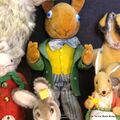Category:Steiff
| Toy Brands and Manufacturers |
|---|
Steiff |
At 18 months old, Margarete Steiff (24 July 1847 - May 9, 1909) suffered a high fever and as a result her legs became paralysed and it was painful to use her right arm. Three years later, she was diagnosed with polio, and all attempts at finding a cure were unsuccessful. However, despite this, Margarete strove to lead a normal life. In spite of the pain in her right hand, Margarete took sewing lessons, and at the age of 17, she finally completed her training as a seamstress. She started working part-time in a shop owned by her sisters, Marie and Pauline, and when they left their home town some 8 years later, Margarete continued to run the store on her own. From her first earnings, Margarete bought a sewing machine, and in 1877, she opened a ready-to-wear felt clothing business. Shortly after the founding of her business, she sewed a pincushion shaped like a small elephant, named “Elefäntle", which was based on a pattern she found in an issue of "Modenwelt" magazine. These small fabric animals proved to be very popular, and in 1880, Margarete Steiff GmbH was officially founded, with the Elefäntle being the company’s first big-selling product. In 1890, Margarete's brother Fritz built her a house with a small shop on the ground floor, and the street on which this house was built is still known as "Margarete-Steiff-Strasse” today.
The trademark "Steiff - Button in Ear" was developed by one of Margarete's nephews, Franz Steiff, in 1902. The aim of this trademark was to distinguish the Steiff products from cheap imitations. Another of Margarete's nephews, Richard Steiff, made detailed drawings of zoo animals, including bears, which were modified for designs suitable for the Steiff range. This was the key to their success! Quick to respond to the Teddy Rooseveldt incident, they exhibited at the 1903 Leipzig Toy Fair and a buyer from New York ordered 3,000 bears to sell in his department store. Steiff made about 975,000 bears each year. Other manufacturers tried to emulate Steiff's success, but the Steiff name remains associated with top-quality bears.
References
- Pauline Cockrill, The Teddy Bear Encyclopedia (Dorling Kindersley 1993, 2001), ISBN 0751333913
- Pauline Cockrill, The Ultimate Teddy Bear Book (Dorling Kindersley 1991), ISBN 0863186556
- History of Steiff Bears (steiffteddybears.co.uk)
- History of the Teddy Bear (sarahbears.com)
- The Steiff Museum, Germany (steiff.com)
Subcategories
This category has the following 2 subcategories, out of 2 total.
C
- Cuddly Toys (display) (25 P, 3 F)
T
- Teddybears' Picnic (display) (26 P, 16 F)
Pages in category ‘Steiff’
The following 18 pages are in this category, out of 18 total.
Media in category ‘Steiff’
The following 8 files are in this category, out of 8 total.
- Alphonso Bear (Steiff).jpg 600 × 400; 121 KB
- Area 34.jpg 1,198 × 1,200; 792 KB
- Early Plush and Steiff bears (Mace 1907).jpg 459 × 1,200; 91 KB
- George the Steiff Bear.jpg 1,067 × 800; 200 KB
- Nelly the Snail (Steiff).gif 667 × 500; 663 KB
- Peter Rabbit 1905 (Steiff).jpg 800 × 1,067; 209 KB
- Polar the Titanic Bear.jpg 1,200 × 900; 196 KB
- Steiff 'Knopf Im Ohr' ear tag.jpg 800 × 447; 211 KB









